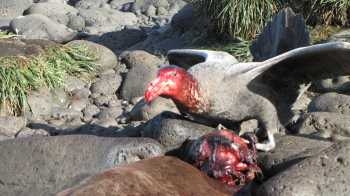Andrea Raya Ray (CONICET, Ushuaia, Argentina) and colleagues, writing in the journal Marine Biology, have studied diets of Southern Giant Petrels Macronectes giganteus at different colonies by looking at isotopic signatures in blood and feathers.
The paper's abstract follows:
"We examined the isotopic signatures (δ13C, δ15N) of adult body feathers from southern giant petrels Macronectes giganteus collected at two breeding colonies in Antarctica (Potter Peninsula and Cape Geddes) and one in southern Patagonia (Observatorio Island), as well as in whole blood collected from adults of both sexes at each Antarctic colonies and from chicks at Potter Peninsula. As body feather moult is a continuous process in giant petrels, feathers provide an integrated annual signal of an adult's diets and foraging habitats. In contrast, the stable isotope values of adult and chick blood are reflective of their diets during the breeding season. We found that sex-specific dietary segregation in adults breeding in Antarctica was notable during the breeding season (blood samples) but absent when examined across the entire year (feather samples). In addition, blood stable isotope values differed between chicks and adults, indicating that adults provision their offspring with a relatively higher amount of penguin and seal prey that [sic] what they consume themselves. This finding confirms previous work that suggests that chicks are preferentially fed with prey of presumably higher nutritional value such as carrion. Finally, based on isotopic differences between major oceanographic zones in the Southern Ocean, our data indicate population-specific differences in foraging distribution, with Antarctic populations move seasonally between Antarctic and subantarctic zones, while Patagonian populations likely forage in subtropical waters and in continental shelf habitats year-round."

Southern Giant Petrel feeding on an elephant seal carcass
Photograph by John Cooper
Reference:
Raya Ray, A., Polito, M., Archuby, D. & Coria, N. 2012. Stable isotopes identify age- and sex-specific dietary partitioning and foraging habitat segregation in southern giant petrels breeding in Antarctica and southern Patagonia. Marine Biology DOI: 10.1007/s00227-012-1912-y.
John Cooper, ACAP Information Officer, 3 April 2012

 English
English  Français
Français  Español
Español